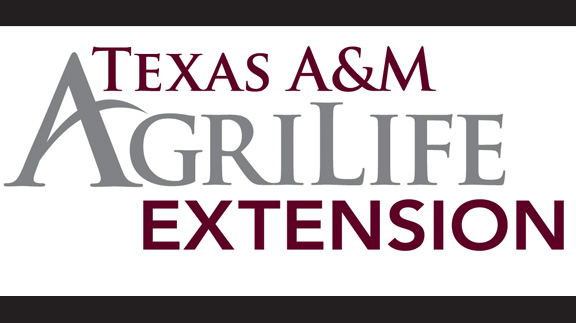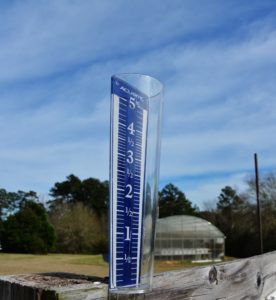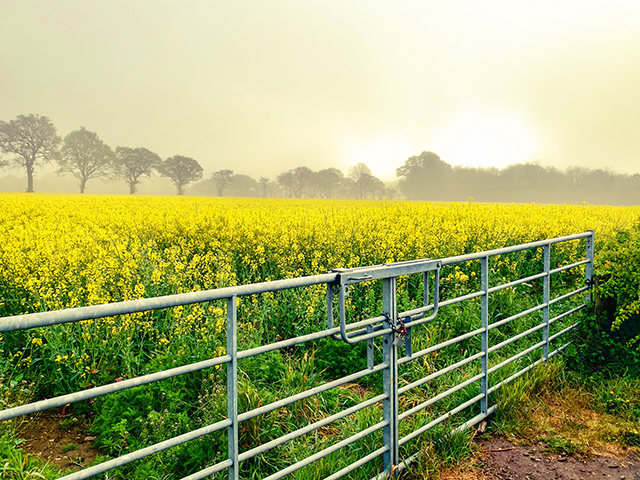Farm & Ranch
[AgriLife Today] Texas Crop Weather Report – Feb. 9

By: Adam Russell
Wet weather headed to Texas
- Writer: Adam Russell, 903-834-6191, [email protected]
- Contact: Dr. John Nielsen-Gammon, 979-862-2248, [email protected]
COLLEGE STATION – A pattern of wet weather lies ahead for much of the state following a dry winter, said the state climatologist.
The rain could mean a short-term reprieve for much of the state needing moisture following the warmest winter months for Texas in decades.

A rain gauge at the Texas A&M AgriLife Research and Extension Center in Overton sits empty. Expected rains this coming weekend could change that. (Texas A&M AgriLife Extension Service photo by Adam Russell)
Dr. John Nielsen-Gammon, in the Texas A&M University department of atmospheric sciences in College Station said expectations going into winter were for weather conditions to be warmer and drier than average throughout the season.
Nielsen-Gammon said records show it was the warmest November through January for the state of Texas since the Dust Bowl of the 1930s. A few stations in the lower Rio Grande Valley recorded temperatures as high as 96 degrees in January. Many stations in that region and along the coast never recorded a low daily temperature below 70 degrees throughout the month.
On the cold side, temperatures did reach -9 degrees in the Panhandle at Dalhart, he said. But cold fronts were short-lived and intermittent for much of the state.
Rainfall was a mixed bag for Texas since November, Nielsen-Gammon said. Most of West Texas received higher-than-normal rainfall amounts, while North Central Texas and surrounding areas received below-normal rainfall.
Nielsen-Gammon does expect chances of wet weather for most of the state starting over the weekend. The rains should pacify concerns about wildfires as the state heads into the season when dead foliage and grass can become dangerous fuel for fires when mixed with high winds and a spark.
“We haven’t seen any substantial drought developing except maybe in the Corpus Christi area, but there have been lingering drought conditions in parts of the state from early fall,” he said.
Nielsen-Gammon also expects temperatures to fall briefly in the near future.
There may be a brief cool front later this week, with a slow moving cold front expected for the beginning of next week, he said.
“We could see a front slowly creeping across Texas with decent blasts of cold air especially in North Texas,” he said. “We’ll just have to see how far that cold air makes it.”
But he does expect fairly warmer patterns to prevail and to keep temperatures at or above average.
“I just don’t see any prolonged cool weather at this point,” he said.
AgriLife Extension district reporters compiled the following summaries:
CENTRAL: Fields with small grains were starting to dry. Field work resumed with fertilization and weed control. Wheat fields looked good. Livestock were looking good with supplemental feeding. Farmers were about to start planting corn. Rangeland was in good shape. Pest numbers increased due to warmer weather. Precipitation kept subsoil moisture at above-average levels. Rains helped tanks, creeks and rivers maintain high levels. Wheat continued to grow well.
ROLLING PLAINS: Soil conditions continued to be dry in parts of the district with above-normal temperatures and zero moisture. Windy conditions were drying out pastures and rangelands, which caused wildfire concerns for producers. The lack of moisture and spring-type weather allowed cotton farmers to harvest fields quickly without any down time. This year’s crop yielded better than expected. Subsoil moisture was good. Stocker cattle were being turned out on wheat fields. Livestock were in good condition. Calving season continued. Range and pastures were in good condition.
COASTAL BEND: Mild temperatures and adequate moisture levels were reported. Producers were preparing for corn planting within the next few weeks. Preplant fertilizer applications and bedding activity occurred. Spring-like weather prompted some peach varieties to bloom. Some areas reported some damage to pastures after the freeze, but they were greening with the above-normal temperatures. Cattle and calves were doing well for this time of the year, and livestock continued to be fed from an oversupply of older hay as well as plenty baled in 2016.
EAST: Dry weather conditions were reported for most of the region. A few counties reported light drizzle. Windy weather contributed to a drying out of soil moisture. Subsoil and topsoil were still mostly adequate. All counties needed rain. Pasture and rangeland conditions were fair to good. Producers were planting gardens and getting spring beds ready. Some growers were concerned about not getting enough chill hours for fruit trees. Temperatures remained warm during the day and cool to cold at night. Some ryegrass was growing. Winter pastures were growing slowly due to a shortage of rain. Shelby County reported winter pastures were in good shape. Producers were making forage management plans regarding establishment and maintenance in Polk County. Hay and supplemental feeding continued. In Trinity County, some cattle were not eating hay during the day as they chased green grass sprouts, but they returned to the hay rings at night. Spring calves were being born and growing well. Producers were getting bulls ready or making purchases in preparation for the spring breeding season. Cattle were in good condition. Cattle prices were lower at local markets. Wild pigs were active with several being seen on the highways after being hit by vehicles.
SOUTH PLAINS: Subsoil and topsoil moisture conditions continued to drop due to lack of moisture. Pastures and rangeland remained in fair condition but needed rain. Harvests were completed, and producers were preparing land for spring planting. Winter wheat growth rates were slow, and field conditions were poor due to cold weather. Temperatures in Hale County were above normal. Winter wheat in Floyd County was in decent shape. Most cotton gins had completed operations for the season. Field activities included shredding of stalks and fertilizer applications. Producers were booking seed, working to negotiate lease agreements and arranging operating loans. Other activities included deep tillage, herbicide applications and incorporation procedures.
PANHANDLE: Conditions were dry and windy with near normal temperatures. Soil moisture levels were mostly adequate. Some field work was in progress. Hall County pastures and range conditions continued to improve as spring-like conditions emerged. Cotton harvest was close to completion with yields and quality grades looking good. Cattle condition scores continued to decline with pasture conditions. Some land preparation was in progress for spring planting. Moisture helped land preparation. Cattle were supplemented.
NORTH: Topsoil and subsoil moisture levels varied from adequate to short. There was no significant rainfall, as warm and windy conditions predominated. Wheat and oat pastures were actively growing and looked good due to the warm weather. Producers applied fertilizer where needed. The dry conditions allowed farmers to get into fields earlier to prepare for spring planting. Stockers were beginning to get some measurable grazing and were in good shape. Cow and calf outfits reported cows in good shape with spring calving going smoothly so far. Cow body condition scores averaged from 6-7. Ranchers were not shy about feeding plenty of hay due to an overabundance of bales. The biggest challenge for livestock were major swings in temperatures. Feral hogs were a problem and were being caught through the trapping program.
FAR WEST: Temperature highs were in the 70s with lows in the 30s. No precipitation was reported. Windy conditions prevailed. Wheat continued to make slow progress. Fertilization of fields began, and growing points were nearing the soil surface. Cattle conditions were holding. There was little green forage in pastures due to a lack of rainfall.
WEST CENTRAL: Unseasonably warm and windy conditions continued and were expected to continue. Chances of rain were forecast. Most areas needed rain for good soil moisture. Preparations for spring planting were underway in some areas. Many producers were waiting on rain to help soil moisture levels before plowing. Cotton harvest was mostly complete. Gins were about 80 percent finished. Wheat emerged and was in fair to good condition. Cotton producers shredded stalks and plowed. Rangeland and pasture conditions were prime for wildfires and prescribed burning. Livestock remained in fair to good condition. Small grains were grazed by livestock. Supplemental feeding continued. Cattle markets remained active, and demand was good.
SOUTHEAST: Livestock were in good condition. Farmers will likely start planting corn in the next week. Unusually warm temperatures were reported. Topsoil was beginning to dry somewhat depending on the soil type. A cold front dropped temperatures in Waller County considerably. Most days were clear; however, some mornings had fog. Most deciduous trees budded out. Bermuda grass pastures showed light greening and growth. Ryegrass started to head out in ungrazed areas. Weather conditions allowed spring pasture planting activities. Jefferson County experienced scattered showers. Soil moisture levels throughout the region ranged widely from adequate to surplus with most ratings in the adequate range. Rangeland and pasture ratings varied widely too, from excellent to very poor, with fair ratings being most common.
SOUTHWEST: Conditions remained the same. Soil moisture levels were drying. Most of the area experienced unseasonably warm temperatures. Fields were being prepared for corn planting. Livestock, rangeland and pasture conditions remained fair.
SOUTH: Weather was cool in the evening and warm during the day, including lows in the 40s and mid-80s in some areas. No significant rain was reported, but light scattered showers fell in parts of the district. Field work started or continued for spring cotton, corn and sorghum planting. Potato planting continued. Wheat and oat crops emerged and were under irrigation throughout the area. Pasture and range conditions were fair to poor and were declining in most areas. Supplemental feeding for livestock continued. Live Oak County experienced another freeze and two dry and windy northern fronts. Producers were actively burning old pasture grass. Cattle body condition scores remained fair. Soil moisture conditions ranged from adequate to short. The cattle market was on a positive trend. Some farmers applied pre-emergence herbicides and fertilizers in some areas. Warm-season grasses tried to green but were slowed by lack of moisture. Coastal Bermuda grass remained dormant and yellow. Conditions forced producers to apply irrigation to wheat, oats, cabbage, spinach, onions, carrots and broccoli. Some cabbage harvesting occurred in local fields, but cabbage market prices were low. Crop producers also prepared to plant tomatoes and onions.
-30-
Find more stories, photos, videos and audio at http://today.agrilife.org
Farm & Ranch
Meanwhile, Back at the Ranch…

By Rayford Pullen | [email protected]
When May arrives, we start thinking about weed control. With two years of drought under our belts, grass grazed short and hay stocks depleted, what we do now will influence our forage conditions for the entire year. With 75 percent of our annual warm season forages made by July 15 in North Texas, we need to get the grass growing while the sun shines.
Speaking of the sun shining, the biggest deterrent to growing lots of grass is restricted sunlight, and the biggest sun blockers we have are weeds.
Have you noticed weeds are normally just slightly taller than your grass and are probably blocking 90 percent of the sunlight from reaching the grass itself? So obviously, we need to improve conditions, so sunlight reaches the plants we want to grow.
With grass extremely short, more sunlight is hitting the soil surface now, which in turn results in more weed seed germinating. With the moisture we have received, we expect an abundance of weeds this year.
To read more, pick up a copy of the May issue of NTFR magazine. To subscribe by mail, call 940-872-5922.
Farm & Ranch
Land Market Report: March Land Sales

By Jared Groce
Rural land sales are continuing on a steady pace for early spring, with prices holding very strong with the sell-to-list price ratios remaining very high, even on properties that have been on the market for a longer than usual time period. The total number of transactions are picking up once again as the spring selling season kicks off, and the average acreage continues to decrease.
Larger acreage properties seem to be in higher demand than smaller properties currently, with many buyers simply parking cash in real estate to hedge against inflation. Interest rates seem to have settled down and most experts agree that rates will be reduced by the fed this year. Some lenders have programs in place that allow the buyer to reduce their rates without having to go through a full refinance ordeal.
To read more, pick up a copy of the May issue of NTFR magazine. To subscribe by mail, call 940-872-5922.
Farm & Ranch
Texas FFA State Vice President Weston Parr

Future Farmers of America was founded by a group of farmers in 1928 with the mission of preparing the next generation of agriculture. It has done just that during its 95-year history, as the organization works to give back to others by following its motto, “learning to do, doing to learn, earning to live, living to serve.”
FFA is an organization made up of state associations, and at the helm of the Texas FFA is a team of 12 officers representing their respective areas within the Lone Star State. These individuals dedicate a year of their lives as they serve members, provide leadership, and work together with the state staff and board of directors to develop policy and lead the organization of over 177,000 members.
North Texas is represented by Area IV and Area IV, stretching from Wilbarger County to Bell County and from Runnels County to Grayson County. This year, those chosen to lead this great area are State President Isaac Hawkins Jr., Area IV, and State Vice President Weston Parr, Area V.
Parr is from the Sam Rayburn FFA chapter and the Area V Association, but the leader who now serves more than 19,100 members of Area V entered the FFA organization as a shy teenager who sat in the back of the room.
“I didn’t talk to a whole lot of people. I didn’t know what I wanted to do with my life or where I could see myself, so I wasn’t involved on my high school campus,” Parr recalled.
“Then I started FFA and slowly but surely, my ag teachers worked me into attending more contests, meeting new people, and speaking. I remember the first time I gave an officer speech to my chapter. I can still remember how embarrassing it was. To see the progression from that moment to speaking on stage at the state convention in front of thousands of people. Now I feel like I can enter the industry I want and be successful all because of what FFA afforded me for five years.”
There is not much Parr did not do during his time in high school. His contest participation included chapter conducting, wool judging, cotton judging, wildlife, and job interview, but his favorite was extemporaneous speaking, which he did not start until his senior year of high school.
“I wish I could go back to my freshman, sophomore, and junior years and start that sooner. I think if I had more time, I would have been more successful than I already was, but that was something I didn’t realize I liked at the time. I’m not naturally somebody who likes to speak in public, but it was actually my favorite,” Parr said.
Parr won several awards during his time competing. In 2023 alone, Parr earned the Texas FFA Service-Learning Proficiency title, was a National FFA Service-Learning Proficiency finalist, and a Texas FFA Extemporaneous Speaking finalist. In addition to his CDE and LDE events during high school, he showed commercial steers at Houston, and boilers at most major shows, participated in the county show with projects in ag mechanics, showed goats from time to time, and showed heifers until graduation.
“FFA provides invaluable resources and knowledge to be successful once you leave high school and you are out of the blue jacket for the first time. I have been a part of a lot of great organizations over the years, and they are all great in their own way, but in my opinion, FFA is the most successful at producing members of society who want to go and do something with themselves,” Parr said.
He was halfway through his time as Area V Association President and attending the national convention when he began to ponder the idea of running for state office.
“This is around the time when you usually figure out if you want to go through and be a state officer or you decide that area officer is your last run. I was unsure of where I wanted to go, but I knew I didn’t want to be done with FFA. I decided maybe it would be a good opportunity not only for me to make more friendships and connections, but also to give back to the program that allowed me to be able to do what I can do today,” Parr explained.
To read more, pick up a copy of the May issue of NTFR magazine. To subscribe by mail, call 940-872-5922.
-

 Country Lifestyles1 year ago
Country Lifestyles1 year agoScott & Stacey Schumacher: A Growth Mindset
-

 Equine8 months ago
Equine8 months agoThe Will to Win
-

 Country Lifestyles7 years ago
Country Lifestyles7 years agoStyle Your Profile – What your style cowboy hat says about you and new trends in 2017
-

 Country Lifestyles4 years ago
Country Lifestyles4 years agoAmber Crawford, Breakaway Roper
-

 HOME7 years ago
HOME7 years agoGrazing North Texas – Wilman Lovegrass
-

 Country Lifestyles7 years ago
Country Lifestyles7 years agoDecember 2016 Profile, Rusty Riddle – The Riddle Way
-

 Outdoor9 years ago
Outdoor9 years agoButtercup or Primrose?
-

 Country Lifestyles8 years ago
Country Lifestyles8 years agoJune 2016 Profile – The man behind the mic: Bob Tallman






